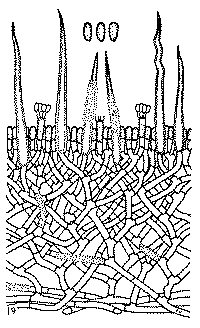|
 Hymenochaete rhabarbarina Hymenochaete rhabarbarina
SynonymsCorticium rhabarbarinum
Stereum rhabarbarinum
BiostatusPresent in region - Indigenous. Non endemic
Images (click to enlarge)
Caption: FIG. 19. Hymenochaete rhabarbarina (Berk.) Cke. Transverse section x 500; spores x 1000.
Note granules of mucilage ensheathing some of the setae and context hyphae. |
Article: Cunningham, G.H. (1957). Thelephoraceae of New Zealand. XIV. The genus Hymenochaete. Transactions of the Royal Society of New Zealand 85(1): 1-51.
Description: Hymenophore resupinate, annual, membranous, adnate, at first developing as numerous
orbicular scattered colonies 2-5 mm diameter, merging to form elongate areas to 15 x 5 cm.
Hymenial surface at first fulvous, or rhubarb, becoming cinnamon, even, at length irregularly
areolately creviced; margin thinning out, fulvous, fibrillose, adnate. Context fulvous, 100-300
µ thick, composed of loosely intertwined hyphae, without a cortex; hyphal system monomitic;
generative hyphae 4-5 µ diameter, walls 0.25 µ thick, pallid yellow brown, freely branched at
a wide angle, corymbose beneath the hymenium, septate. Setal layer confined to the
subhymenium, of one or two rows with occasional scattered setae in the context; setae
somewhat sparse, projecting for the greater part of their length, aculeate, 65-95 x 6-8 µ, walls
naked or coated with brown gelatinous granules, fragile, light reddish-brown, lumina narrow.
Hymenial layer a dense palisade of basidia and paraphyses. Basidia subclavate, 14-18 x 5-6 µ,
4-spored; sterigmata arcuate, slender, to 5 µ long. Paraphyses subclavate, 6-9 x 4-5 µ, tinted
below. Spores elliptical or obovate, apiculate, 5-6 x 2.5-3 µ, walls smooth, hyaline, 0.1 µ
thick.
Habitat: HABITAT: Effused on bark of dead trunks and limbs associated with a pocket rot.
Distribution: TYPE LOCALITY: Otawa, New Zealand. DISTRIBUTION: Australia, New Zealand.
Notes: Collections match the type in Kew herbarium, ex "Colenso, N.Z." The species may be
identified by the resupinate, fulvous or cinnamon fructifications, with long aculeate setae.
The latter project for the greater part of their length, and are often partly coated with sheaths
of gelatinous granules. Similar granules are present on occasional hyphae of the context.
Context hyphae branch at a wide angle, are 1-5 µ diameter with thin walls, and beneath the
hymenium become almost corymbose. They resemble the hyphae of H. cinnamomea, from
which the species may be separated by the absence of strata and paraphysate hyphae, presence
of mucilage granules, different setae and spores. In old specimens setae may be arranged in
two or three obscure layers. Such plants may be confused with H. unicolor, from which the
species is separated by the different arrangement of context hyphae, different spores and
presence of a well developed intermediate tissue.
Article: Cooke, M.C. (1879). New Zealand fungi. Grevillea 8(46): 54-68.
|